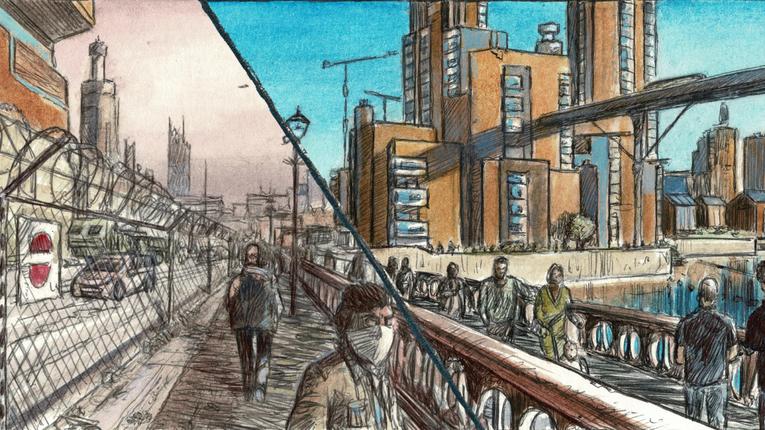To assimilate the many millions who remain excluded into a future of opportunity and a better quality of life, we need to get smarter about how we integrate nature into our cities, digitise our people and enable them to uplift and empower themselves, says Siwe Ntombela.
If you must consider what the city of 2050 looks like, it's probable that images of flying cars, endless streets of skyscrapers and ubiquitous digital connectivity come to mind. While this may be true for some of the more developed cities in the world, for South Africa we run the risk of having more of the same if we do not address our rampant issues of inequality.
Most of those who inhabit our cities live along its periphery which literally and figuratively disconnects them from playing an active role in its economy. Access to work opportunities are fewer and being digitally connected harder, placing millions in positions of exclusivity. Enabling inclusivity should be our number one goal, a yardstick to aim for within the next 30 years that dissolves the barriers to entry (work, life, economic, social) experienced by so many for so long.
Listening from the bottom up
It starts at the grassroots level. We can easily fall into the trap of believing that grand efforts and infrastructure improvements will solve our city's challenges of inequality. This is both costly and most importantly, slow meaning it can take years, if not decades, to yield any tangible return. Rather, we should be looking at what communities can, and are, doing for themselves today.
Consider the adoption of a cycling culture. Bikes are used to uplift communities economically in a myriad of ways. Not only do they provide a sustainable mode of transport, but they can also be used as delivery and safety patrol vehicles. There are also the many ancillary bike businesses cropping up too, such as maintenance of bikes and even riding lessons.
Another opportunity is capitalising on food. In the absence of having access to Uber Eats in the townships, youth are developing their own technology platforms that allow people to order food to be delivered to their homes, using bikes. Such an example is Cloudy Deliveries in Cape Town which is working with Langa Bicycle Hub, or the Thumela app which is used by residents of eSikhawini in KwaZulu-Natal. In so doing they are learning from the big players and creating an economy for themselves around a daily demand.

Communities are innovating and uplifting themselves. They are not relying on the local government or partners to solve their problems because they are also not being heard. Instead of being integrated into city solutions that affect them the most, they are left marginalised, especially by the local government, which is viewed with much scepticism. To create a future of inclusivity, the very officials who are tasked with the upkeep and safety of these communities first need to listen.
Allowing nature back into our cities
Integrating nature back into our cities and its peripheries is also of critical importance for a more inclusive future. Urbanisation is leading to overcrowding which places a high demand on our resources. Given that by 2050 it's projected that more than two-thirds of the world's population will live in urban areas, we can expect the same trend at home and our cities will become even more overpopulated.
We cannot continue to build and build, we are already running out of space; we need sustainable solutions that directly affect the most vulnerable. We can start by rethinking how we use wasted space. Within the inner cities, there are plenty of empty buildings that could be turned into affordable housing or be used for urban farming. This kills two birds with one stone, addressing both access to places to live and thus more work opportunities, as well as food security. Rooftops and vacant plots can be turned into community gardens, which not only brings nature back into the cities, but creates its own economy and jobs too.
Accessibility through technology
Alongside bringing the wilderness back into our cities, we also need to rapidly increase access to digitisation. There is no doubt technology will play a significant role in our day-to-day lives, yet as it stands, millions of those who live in cities remain unconnected. Data is expensive, digital connections are weak and while wifi should be free and ubiquitous, it remains out of reach for most. This automatically restricts access to work opportunities, and as we have seen from Covid-19, those who are connected have become entirely dependent on technology to do everyday tasks, from learning and working to shopping. Those who aren't remain excluded from even the simplest of activities.
Thirty years may sound like a long time, but we are still dealing with the legacy of apartheid and spatial transformation is happening at a snail's pace. To assimilate the many millions who remain excluded into a future of opportunity and a better quality of life we need to get smarter about how we integrate nature into our cities, digitise our people and enable them to uplift and empower themselves. Flying cars and omnipresent technology may well be our everyday realities in decades to come but if we don't fix the issues of inequality and exclusivity today, we will only take them with us into our future.
In an effort to engage South Africans on what the city of 2050 looks like, the South African Cities Network has launched the #MyCityMyLens poster competition, hosted on Facebook and Instagram. It asks entrants to imagine what the future of African culture in cities will look like by submitting a poster in GIF, illustration, sketch or image format with a 100-word write-up. Entries close on 18 October. Visit the SACN website for more details.
* Siwe Ntombela represents the South African Cities Network. Views expressed are her own.




